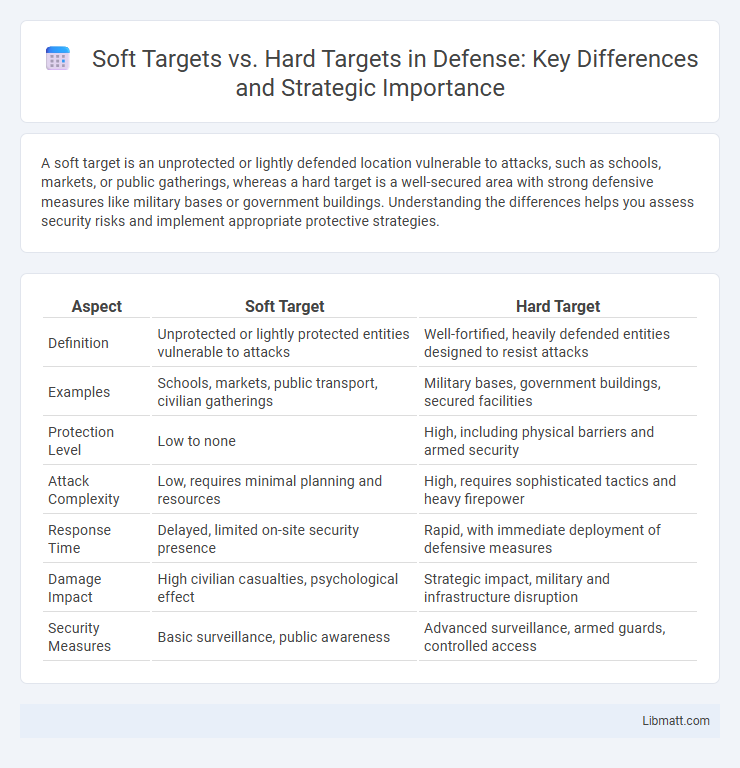A soft target is an unprotected or lightly defended location vulnerable to attacks, such as schools, markets, or public gatherings, whereas a hard target is a well-secured area with strong defensive measures like military bases or government buildings. Understanding the differences helps you assess security risks and implement appropriate protective strategies.
Table of Comparison
| Aspect | Soft Target | Hard Target |
|---|---|---|
| Definition | Unprotected or lightly protected entities vulnerable to attacks | Well-fortified, heavily defended entities designed to resist attacks |
| Examples | Schools, markets, public transport, civilian gatherings | Military bases, government buildings, secured facilities |
| Protection Level | Low to none | High, including physical barriers and armed security |
| Attack Complexity | Low, requires minimal planning and resources | High, requires sophisticated tactics and heavy firepower |
| Response Time | Delayed, limited on-site security presence | Rapid, with immediate deployment of defensive measures |
| Damage Impact | High civilian casualties, psychological effect | Strategic impact, military and infrastructure disruption |
| Security Measures | Basic surveillance, public awareness | Advanced surveillance, armed guards, controlled access |
Understanding Soft Targets and Hard Targets
Soft targets are vulnerable entities with minimal protection such as schools, malls, and public transportation hubs, making them susceptible to attacks due to open access and high population density. Hard targets are well-protected locations like government buildings, military installations, and airports, featuring robust security measures including checkpoints, surveillance, and restricted access. Understanding the distinction between soft and hard targets is crucial for developing effective security strategies and risk mitigation plans.
Key Differences Between Soft and Hard Targets
Soft targets are typically unprotected, civilian locations like schools, malls, or places of worship, making them more vulnerable to attacks due to minimal security measures. Hard targets include government buildings, military installations, and critical infrastructure guarded by extensive physical barriers and surveillance systems. Understanding these key differences helps you assess security risks and implement appropriate protective strategies.
Characteristics of Soft Targets
Soft targets are characterized by their lack of robust security measures and their accessibility to the general public, making them vulnerable to attacks or disruptions. Common examples include public venues such as schools, shopping malls, and places of worship where high foot traffic and minimal protective barriers exist. These locations often have limited surveillance, fewer security personnel, and open entry points, which increase the risk of unauthorized access and potential threats.
Characteristics of Hard Targets
Hard targets are highly fortified and protected locations designed to withstand attacks, featuring reinforced structures, advanced security systems, and controlled access points. These targets often include military installations, government buildings, and critical infrastructure with strict surveillance and defense mechanisms to deter and prevent unauthorized entry. Your security strategy must account for the resilience and complexity of hard targets to effectively mitigate potential threats.
Common Examples of Soft Targets
Soft targets commonly include public places such as schools, shopping malls, stadiums, and places of worship where large groups gather with minimal security measures. These locations are vulnerable to attacks due to their accessibility and the difficulty in implementing strict security controls. High-profile soft targets also encompass transportation hubs like airports and train stations, which attract significant foot traffic and present challenges for comprehensive screening.
Common Examples of Hard Targets
Common examples of hard targets include military installations, government buildings, airports, and embassies, all of which are reinforced with security measures such as armed guards, surveillance systems, and fortified structures. These locations are designed to resist attacks and prevent unauthorized access, making them significantly more difficult to breach compared to soft targets like public spaces or commercial centers. High-value infrastructure such as nuclear power plants and critical communication hubs also fall under the category of hard targets due to their strategic importance and robust defense mechanisms.
Vulnerabilities Associated with Soft Targets
Soft targets are typically unprotected or lightly secured locations such as schools, malls, and public gatherings, making them highly vulnerable to attacks due to the lack of substantial physical barriers and security personnel. These vulnerabilities include easy accessibility, minimal surveillance, and high population density, which can lead to significant casualties and disruption. Enhancing Your security measures in such environments is crucial to mitigate risks associated with soft target vulnerabilities.
Security Measures for Hardening Targets
Implementing security measures for hardening targets involves reinforcing physical barriers, deploying advanced surveillance systems, and enhancing access control protocols to deter potential threats effectively. Utilizing biometric authentication, armored materials, and cybersecurity defenses ensures robust protection of critical infrastructure and sensitive assets. Your security strategy should integrate layered defenses to minimize vulnerabilities and respond promptly to any breach attempts.
Importance in Security and Defense Strategies
Soft targets, such as public spaces and civilian populations, require enhanced security measures due to their high vulnerability to attacks and limited protective infrastructure. Hard targets, like military bases and government facilities, benefit from physical fortifications and advanced surveillance, making them less susceptible to breaches but demanding continuous threat assessment. Effective security and defense strategies prioritize the identification and reinforcement of both soft and hard targets to mitigate risks and enhance overall resilience against diverse threats.
Emerging Trends in Target Protection
Emerging trends in target protection emphasize advanced surveillance technologies and AI-driven analytics to transform soft targets--open, unprotected spaces vulnerable to attacks--into more resilient zones. Hard targets benefit from integrated biometric access controls and fortified physical barriers, reducing the risk of unauthorized breaches. Increasingly, the convergence of cyber and physical security systems enhances situational awareness, enabling real-time threat detection and rapid response across diverse environments.
soft target vs hard target Infographic

 libmatt.com
libmatt.com